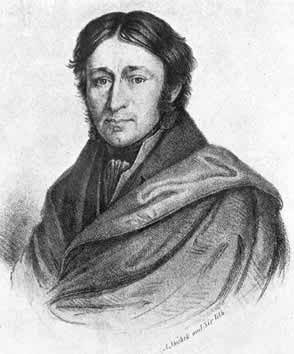Related Research Articles

Carl Friedrich Philipp von Martius was a German botanist and explorer. Between 1817 and 1820, he travelled 10,000 km through Brazil while collecting botanical specimens. His most important work was a comprehensive flora of Brazil, Flora Brasiliensis, which he initiated in 1840 and was completed posthumously in 1906.

Heinrich Gottlieb Ludwig Reichenbach was a German botanist, ornithologist and illustrator. It was he who first requested Leopold Blaschka to make a set of glass marine invertebrate models for scientific education and museum showcasing, the successful commission giving rise to the creation of the Blaschkas' Glass sea creatures and, subsequently and indirectly, the more famous Glass Flowers.

Jan Svatopluk Presl was a Czech natural scientist.

Karl Fritsch was an Austrian botanist. He was born in Vienna and educated mainly at the University of Vienna, obtaining his PhD degree in 1886 and his Habilitation in 1890. In 1900 he moved to the University of Graz as professor of Systematic Botany, where he built up the botanical institute. In 1910 he was appointed as director of the university's botanical garden, and in 1916 the new institute acquired its own building. He continued at Graz for the rest of his career, and died there.

Elmer Drew "E. D." Merrill was an American botanist and taxonomist. He spent more than twenty years in the Philippines where he became a recognized authority on the flora of the Asia-Pacific region. Through the course of his career he authored nearly 500 publications, described approximately 3,000 new plant species, and amassed over one million herbarium specimens. In addition to his scientific work he was an accomplished administrator, college dean, university professor and editor of scientific journals.

Nikolai Stepanovich Turczaninow was a Russian botanist and plant collector who first identified several genera, and many species, of plants.

Giorgio Jan was an Italian taxonomist, zoologist, botanist, herpetologist, and writer. He is also known as Georg Jan or Georges Jan. He was the first director of the natural history museum at Milan.

Ernest Saint-Charles Cosson was a French botanist born in Paris.

William Ashbrook Kellerman was an American botanist, mycologist and photographer.
Gustav Adolf Hugo Dahlstedt was a Swedish botanist who worked at the Bergianska Trädgården and Naturhistoriska Riksmuseet in Stockholm. In 1907 he received his honorary doctorate.

Alexander Zahlbruckner was an Austrian-Hungarian botanist who specialized in the study of lichens. Johann Babtist Zahlbruckner, an earlier Austrian botanist, was his grandfather.

Henry Robert Nicollon des Abbayes was a French botanist and lichenologist. He was the chair of the Botanical Department of the University of Rennes and an expert on the flora of Great Britain. The standard author abbreviation Abbayes is used to indicate this person as the author when citing a botanical name. H.R.N. des Abbayes was editor of four exsiccata series distributing lichen reference specimens among herbaria.
George Knox Merrill was an American lichenologist. He was a leading exponent of lichenology in the early 20th century. He was particularly interested in species of the family Cladoniaceae, in which he published several new species, varieties, and forms. In 1909 he started publishing Lichenes Exsiccati, which he continued intermittently until 1927; 400 specimens were presented in two exsiccata series.

Josephine Elizabeth Tilden was an American expert on pacific algae. She was the first woman scientist employed by the University of Minnesota. Tilden established a research station in British Columbia which lasted only until 1906. When Tilden became an assistant Professor in 1903, she was the first female scientist employed by the University of Minnesota. In 1910, despite not having a doctorate, Tilden was promoted to full professor.

Sylvia Anita Edlund was a Canadian botanist. Festuca edlundiae, commonly known as Edlund's fescue, a high arctic grass, was named in her honour for her extensive contributions to Arctic field work.

Caroline Coventry Haynes was an American bryologist and painter, known for her study of liverworts and other hepatics.
Johann Christoph Schleicher was a Swiss botanist, bryologist, mycologist, pteridologist ,and algologist of German origin. He founded a botanical garden in Bex, and a herbarium trade.

Exsiccata is a work with "published, uniform, numbered set[s] of preserved specimens distributed with printed labels". Typically, exsiccatae refer to numbered collections of dried herbarium specimens or preserved biological samples published in several duplicate sets with a common theme or title, such as Lichenes Helvetici. Exsiccatae are regarded as scientific contributions of the editor(s) with characteristics from the library world and features from the herbarium world. Exsiccatae works represent a special method of scholarly communication. The text in the printed matters/published booklets is basically a list of labels (schedae) with information on each single numbered exsiccatal unit. Extensions of the concept occur.
Philipp Franz Wilhelm von Zwackh-Holzhausen was a German botanist and mycologist.
IndExs – Index of Exsiccatae is an online biological database that plays a pivotal role in documenting more than 2,200 historical and ongoing series of exsiccatae and exsiccata-like works. Managed by the Botanische Staatssammlung München in München, IndExs serves as a comprehensive data repository for these series, providing detailed titles with information on the more than 1,300 editors, bibliographic information, exsiccatal numbers, publication timespans, ranges, information on preceding and superseding series and publishers. Exsiccatae, organised series of biological specimens distributed among biological collections, are essential resources found in major herbaria worldwide. Open access to the general information on exsiccatae facilitates global scientific engagement and research.
References
- 1 2 "Harvard University Herbaria & Libraries - Index of Botanists - Dubovik, Oljga N." Harvard University Herbaria & Libraries . Harvard University . Retrieved 3 March 2022.
- ↑ "Herbarium florae Ukraine: IndExs ExsiccataID=388479872". IndExs - Index of Exsiccatae. Botanische Staatssammlung München. Retrieved 29 April 2024.
- ↑ International Plant Names Index. Dubovik.